-
info@aaanimalcontrol.com
Call us for help in your town
Humane Wildlife Education
Snake Control and Removal
Need snake removal in your hometown? We service over 500 USA locations! Click here to hire us in your town and check prices - updated for year 2020.
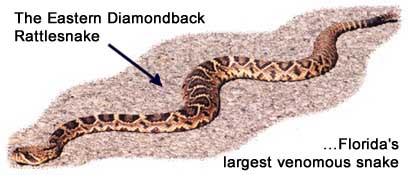 Snake Information: Florida is a home to 45 species of snakes. 6 of them are venomous (see below) and a danger to humans.
All snakes are carnivorous predators that feed on a variety of small prey. Like many predators,
they can be beneficial in the elimination of unwanted vermin such as rodents. However, many people are not
comfortable having snakes around, particularly venomous snakes. Snakes are most often spotted in the yard, but we find them in pools,
inside houses, and even attics. We safely capture and remove snake, and even provide snake trapping and prevention services.
Snake Information: Florida is a home to 45 species of snakes. 6 of them are venomous (see below) and a danger to humans.
All snakes are carnivorous predators that feed on a variety of small prey. Like many predators,
they can be beneficial in the elimination of unwanted vermin such as rodents. However, many people are not
comfortable having snakes around, particularly venomous snakes. Snakes are most often spotted in the yard, but we find them in pools,
inside houses, and even attics. We safely capture and remove snake, and even provide snake trapping and prevention services.
NOTE: If you find a snake and you do not know whether or not it is venomous, the safest thing to do is to leave it
alone and call AAAnimal Control or another trapping professional. If you or someone else is bitten by a poisonous snake, you should immediately
seek medical attention at the nearest hospital or medical facility.
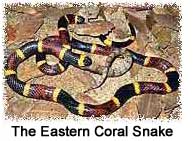 People are most likely to encounter snakes if their property provides good snake habitat. Like
all animals, snakes are looking for a good place to hunt and live. Sometimes people just happen to
come across transient snakes, although I often catch snakes in homes, even snakes in attics. A venomous snake is most dangerous if surprised or provoked. Many
venomous snakes give a warning (such as the rattle of a rattlesnake) or other signs before striking,
though this is not always the case. Snakes must be within striking range in order to inflict a bite.
This varies by snake, but can be up to half the snake's body length. Most venomous bites fall under
accident categories, and (as evidenced by the high number of hand and arm bites) careless handling or
provoking.
People are most likely to encounter snakes if their property provides good snake habitat. Like
all animals, snakes are looking for a good place to hunt and live. Sometimes people just happen to
come across transient snakes, although I often catch snakes in homes, even snakes in attics. A venomous snake is most dangerous if surprised or provoked. Many
venomous snakes give a warning (such as the rattle of a rattlesnake) or other signs before striking,
though this is not always the case. Snakes must be within striking range in order to inflict a bite.
This varies by snake, but can be up to half the snake's body length. Most venomous bites fall under
accident categories, and (as evidenced by the high number of hand and arm bites) careless handling or
provoking.
Let AAAnimal Control safely identify, capture, and remove an unwanted snake.
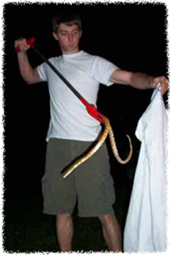 I am familiar with the snakes of Florida, their behavior, and the best method of capture and
transportation. I have specialty professional snake tongs
that exert enough pressure to restrain the snake, but not so much that the snake is exposed to injury.
I safely transport snakes in a snake bag. It is unwise for amateurs to attempt to catch or transport snakes by hand.
If I am unable to catch the snake by tong or hand, I can use snake traps to trap and remove snakes.
Many people want to know how to get rid of snakes. If you have a persistent problem with snakes on your property, I can help.
I am schooled in habitat modification, which will make your property less attractive to snakes. Unfortunately, there are virtually no effective
snake repellents available for sale for snake prevention, but our service incorporates one of the few effective repellents, plus other
services that help keep snakes off your property. I also
have snake traps which I can set to capture a hiding snake in a building. It's important to know that I don't want to
kill snakes, I just want to keep snakes away from your house or property. If you live in the Orlando area, call me any time. If you live outside of Orlando,
look for another pro for professional snake removal services. Remember, if you're ever unsure about a snake, it's best to just leave it alone, and it won't bother you if you don't bother it.
Give us a call, and we can remove the snake in a safe manner, and that failing, set snake traps in your property to catch it.
I am familiar with the snakes of Florida, their behavior, and the best method of capture and
transportation. I have specialty professional snake tongs
that exert enough pressure to restrain the snake, but not so much that the snake is exposed to injury.
I safely transport snakes in a snake bag. It is unwise for amateurs to attempt to catch or transport snakes by hand.
If I am unable to catch the snake by tong or hand, I can use snake traps to trap and remove snakes.
Many people want to know how to get rid of snakes. If you have a persistent problem with snakes on your property, I can help.
I am schooled in habitat modification, which will make your property less attractive to snakes. Unfortunately, there are virtually no effective
snake repellents available for sale for snake prevention, but our service incorporates one of the few effective repellents, plus other
services that help keep snakes off your property. I also
have snake traps which I can set to capture a hiding snake in a building. It's important to know that I don't want to
kill snakes, I just want to keep snakes away from your house or property. If you live in the Orlando area, call me any time. If you live outside of Orlando,
look for another pro for professional snake removal services. Remember, if you're ever unsure about a snake, it's best to just leave it alone, and it won't bother you if you don't bother it.
Give us a call, and we can remove the snake in a safe manner, and that failing, set snake traps in your property to catch it.
 Click here for snake job prices.
Click here for snake job prices.
Note: These are my old personal prices, not applicable nationwide.
 Click here for my snake photo gallery.
Click here for my snake photo gallery.
Dozens of photos of my snake removal work.
 Click for examples of snake control jobs I've done.
Click for examples of snake control jobs I've done.
Get ideas from my snake removal projects.
About Florida Snakes
Florida is home to 45 snake species, many of which may look dangerous to humans. However,
most are ultimately beneficial in the capture of rats and mice. Common non-venomous snake species
include the Black Racer, Corn Snake, Eastern Garter Snake, Milk Snake, Yellow Rat Snake, Banded Water Snake,
Southern Ringneck Snake, and maybe a Southern Black Snake or Rough Green Snake.
Florida is home to six kinds of venomous snakes. There are two types of venomous snakes in
Florida. The Crotalidae, or pit vipers, and the Elapidae. Included in the family of pit vipers are the
Diamondback Rattlesnake, Canebrake Rattlesnake, Pigmy Rattlesnake, Cottonmouth (or Water Moccasin),
and the Copperhead. The venom of these snakes is haemotoxic, that is, it destroys the red blood cells
and the walls of the blood vessels of the victim. The Elapidae, represented in Florida by the Coral
Snake, have neurotoxic venom. This attacks the nervous system of a victim, bringing on paralysis.
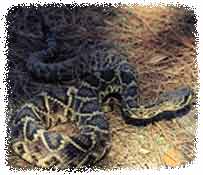 The Eastern Diamondback Rattlesnake is the largest and most dangerous of Florida's native
snakes, and is one of the most poisonous snakes of the world. It is large in size, has a high
quantity of venom, aggressive defensive tactics and tremendous striking speed, thus making this snake one
to be treated with extreme caution. Although it may attain a body length of over eight feet, it is
rare to find an Eastern Diamondback over seven feet long. Rattlesnakes feed on small warm-blooded animals, mainly
rabbits, squirrels, rats, mice, and sometimes birds. When disturbed, rattlesnakes assume a
defensive position with the body coiled around and the head and neck raised in an S-position.
From this stance, the rattler can deliver the venomous strike. It almost always gives a warning rattle
of the tail first. The Eastern Diamondback occurs in every Florida county and prefers rural scrub pine areas. Average adult size is 36-72 inches, and the record is 96 inches.
The Eastern Diamondback Rattlesnake is the largest and most dangerous of Florida's native
snakes, and is one of the most poisonous snakes of the world. It is large in size, has a high
quantity of venom, aggressive defensive tactics and tremendous striking speed, thus making this snake one
to be treated with extreme caution. Although it may attain a body length of over eight feet, it is
rare to find an Eastern Diamondback over seven feet long. Rattlesnakes feed on small warm-blooded animals, mainly
rabbits, squirrels, rats, mice, and sometimes birds. When disturbed, rattlesnakes assume a
defensive position with the body coiled around and the head and neck raised in an S-position.
From this stance, the rattler can deliver the venomous strike. It almost always gives a warning rattle
of the tail first. The Eastern Diamondback occurs in every Florida county and prefers rural scrub pine areas. Average adult size is 36-72 inches, and the record is 96 inches.
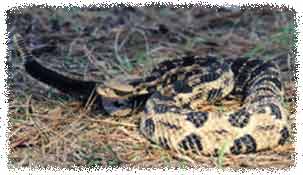 The Canebrake Rattlesnake, also called the Timber Rattlesnake, is restricted mainly to northern Florida but has been reported as far
south as Alachua County. I doubt you'll ever see one in Orlando. This snake is the southern subspecies of the timber rattlesnake found in more northern
portions of the United States. As with other rattlesnakes, the head is much wider than the neck. It is smaller and
more slender in build than the average Diamondback. Florida specimens seldom measure more than five
feet in length. The Timber Rattler is usually found in the flatwoods, fields and around farms. Average adult size is 36-60 inches, and the record is 74.5 inches.
There's no snake repellant to keep away Canebrakes!
The Canebrake Rattlesnake, also called the Timber Rattlesnake, is restricted mainly to northern Florida but has been reported as far
south as Alachua County. I doubt you'll ever see one in Orlando. This snake is the southern subspecies of the timber rattlesnake found in more northern
portions of the United States. As with other rattlesnakes, the head is much wider than the neck. It is smaller and
more slender in build than the average Diamondback. Florida specimens seldom measure more than five
feet in length. The Timber Rattler is usually found in the flatwoods, fields and around farms. Average adult size is 36-60 inches, and the record is 74.5 inches.
There's no snake repellant to keep away Canebrakes!
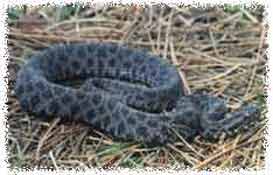 The Pygmy Rattlesnake, also called ground rattler, is common throughout Florida. It is found in
every county. Its rattle is small and slender and produces a sound like the buzzing of an insect, which
may be difficult for people to hear. Most pygmy rattlers measure less than 18 inches in length. It feeds on small
frogs, lizards, mice and other snakes. The Pygmy has a feisty disposition, and is quick to strike. Luckily,
it usually does not inject enough venom to kill an adult human. However, the venom is extremely painful and
damaging to tissue. You do not want to receive a Pigmy Rattler bite! Get
pest control for snakes first. Average adult size is 12-24 inches, and the record is 31 inches.
The Pygmy Rattlesnake, also called ground rattler, is common throughout Florida. It is found in
every county. Its rattle is small and slender and produces a sound like the buzzing of an insect, which
may be difficult for people to hear. Most pygmy rattlers measure less than 18 inches in length. It feeds on small
frogs, lizards, mice and other snakes. The Pygmy has a feisty disposition, and is quick to strike. Luckily,
it usually does not inject enough venom to kill an adult human. However, the venom is extremely painful and
damaging to tissue. You do not want to receive a Pigmy Rattler bite! Get
pest control for snakes first. Average adult size is 12-24 inches, and the record is 31 inches.
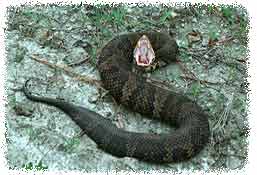 The Cottonmouth or Water Moccasin is an aquatic pit viper without rattles. It occurs
commonly in every county in the state. Often when disturbed it draws into a loose coil, cocks its head
upwards and opens its mouth wide to reveal the white interior lining, earning it the the name cottonmouth. It
does not have to be coiled to strike, but can deliver a bite from almost any position, either in or
out of the water. It is an unpredictable snake. Some individuals are calm and sluggish while others
may be very aggressive. A water snake, the cottonmouth is found along stream banks, in swamps, margins
of lakes and in tree-bordered marshes. It hunts at night for its prey of fish, frogs and other snakes,
lizards and small mammals. The poisonous bite of this reptile results in great pain and severe swelling. With
immediate and proper medical treatment, the bite is only occasionally fatal to humans. Average adult size is 20-48 inches, and the record is 74.5 inches.
The Cottonmouth or Water Moccasin is an aquatic pit viper without rattles. It occurs
commonly in every county in the state. Often when disturbed it draws into a loose coil, cocks its head
upwards and opens its mouth wide to reveal the white interior lining, earning it the the name cottonmouth. It
does not have to be coiled to strike, but can deliver a bite from almost any position, either in or
out of the water. It is an unpredictable snake. Some individuals are calm and sluggish while others
may be very aggressive. A water snake, the cottonmouth is found along stream banks, in swamps, margins
of lakes and in tree-bordered marshes. It hunts at night for its prey of fish, frogs and other snakes,
lizards and small mammals. The poisonous bite of this reptile results in great pain and severe swelling. With
immediate and proper medical treatment, the bite is only occasionally fatal to humans. Average adult size is 20-48 inches, and the record is 74.5 inches.
 The Copperhead is rarely if ever identified in the Orlando area. Most Florida Copperheads
are confined to the panhandle. Many snakes that are reported to be Copperheads turn
out to be young Cottonmouths which are similar in appearance. Even more commonly, a common water snake like the Banded Water Snake is mistaken for a Copperhead snake. The copperhead's bite is less severe
than the cottonmouth's bite. This snake is well-known as one of the venomous snakes in many parts of the
United States, but you'll never see one in the Orlando area. Many people call for snake extermination
due to this snake, but most people's fears are unfounded, and identifications incorrect. The copper-colored head is wider than
the neck. Average adult size is 22-36 inches, and the record is 53 inches.
The Copperhead is rarely if ever identified in the Orlando area. Most Florida Copperheads
are confined to the panhandle. Many snakes that are reported to be Copperheads turn
out to be young Cottonmouths which are similar in appearance. Even more commonly, a common water snake like the Banded Water Snake is mistaken for a Copperhead snake. The copperhead's bite is less severe
than the cottonmouth's bite. This snake is well-known as one of the venomous snakes in many parts of the
United States, but you'll never see one in the Orlando area. Many people call for snake extermination
due to this snake, but most people's fears are unfounded, and identifications incorrect. The copper-colored head is wider than
the neck. Average adult size is 22-36 inches, and the record is 53 inches.
 The Coral Snake's venom is the most potent of any of North America's snakes per volume. It carries
neurotoxic venom (attacks nervous system). It has short fixed fangs
and a small mouth. It does not strike and inject venom like the pit vipers but bites and almost has hold on for a little while to inject its poison.
Many people use this rhyme "red touch yellow, kill a fellow; red touch black, okay Jack." to differentiate
the Coral Snake from non-venomous copycats like the Scarlet King Snake. It occurs throughout Florida, primarily
in heavy brush, nearly underground, occasionally emerging after heavy rains. Average adult size is 20-30 inches, and the record is 47.5 inches.
The Coral Snake's venom is the most potent of any of North America's snakes per volume. It carries
neurotoxic venom (attacks nervous system). It has short fixed fangs
and a small mouth. It does not strike and inject venom like the pit vipers but bites and almost has hold on for a little while to inject its poison.
Many people use this rhyme "red touch yellow, kill a fellow; red touch black, okay Jack." to differentiate
the Coral Snake from non-venomous copycats like the Scarlet King Snake. It occurs throughout Florida, primarily
in heavy brush, nearly underground, occasionally emerging after heavy rains. Average adult size is 20-30 inches, and the record is 47.5 inches.
This website has many great snake photos, taken by Daniel Dye: (Several snake pictures on my web page are courtesy of Dan and his photography skills)
http://www.floridabackyardsnakes.com/
For more snake information, check out the Online Guide to Snakes of Florida:
http://www.flmnh.ufl.edu/natsci/herpetology/fl-guide/onlineguide.htm
Click here if you need Tampa Snake Control.


















